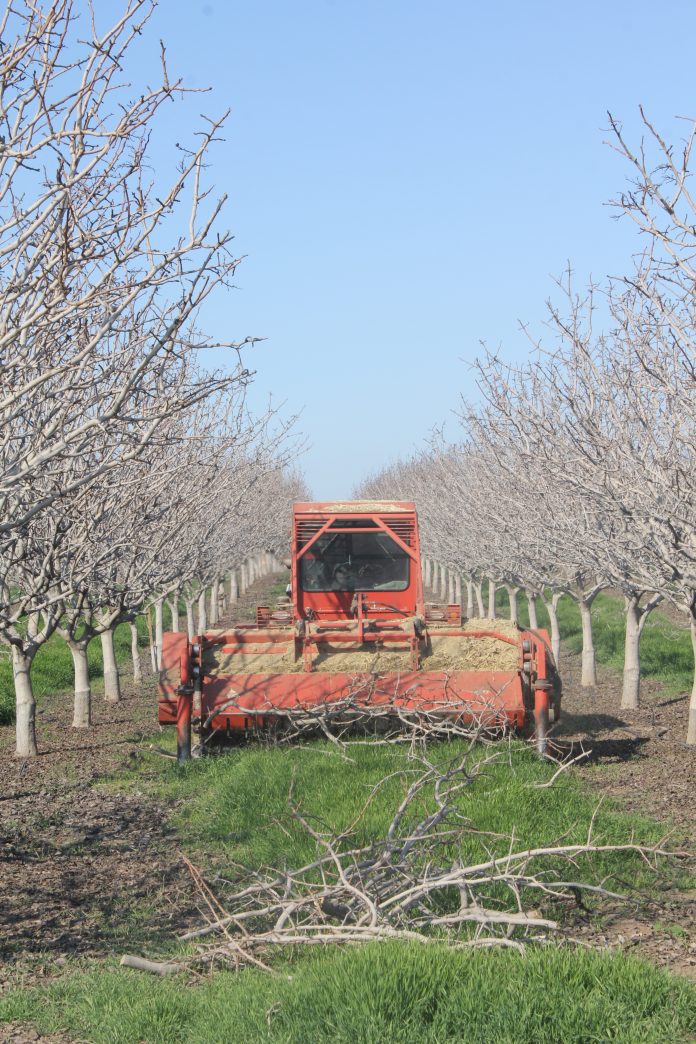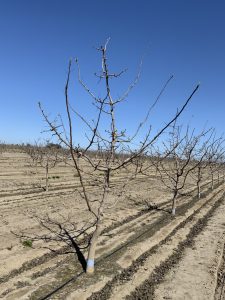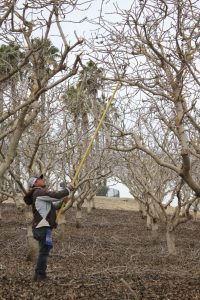
A California Pistachio Research Board-funded tree training and staking trial looks to bring pistachio trees into production more rapidly, at a lower cost while improving water use efficiency and establishing a strong tree structure.
Led by UC Davis Plant Biologist Bruce Lampinen, this trial compared conventional pistachio tree training from the Pistachio Production Manual with wooden stakes, a modified central leader on 5/16 inches by eight feet with metal stakes and untrained 3/8 inches by 10 feet with metal stakes.
The trial consisted of two sites in Kings County, one in Yolo County and another at the Westside Research Station planted in 2019. The first Kings County site was initiated in a Lost Hills on PG1 seedling rootstock with double line drip irrigation. The second Kings County site was also Lost Hills on PG1 rootstock, planted in the summer of 2016 and budded in July 2016. The Yolo site used nursery grafted trees.
The modified central leader trial had trees headed at 62 inches at the end of the first dormant season. There was no in-season tipping, only dormant pruning. No shoots were removed, but all shoots that grew more than 18 to 24 inches were tipped. In addition, the most central shoot was tipped and retrained to a central leader and left longer than all other shoots.

The untrained trial at 3/8 inches by 10 feet and metal stakes had no heading or pruning; only limbs that were too low were removed. Lampinen noted that modified central leader and untrained trees were attached to the metal stakes with flexible ties that allow some movement, and as the trunks grow, the ties release themselves. Photosynthetically active radiation interception (PAR) was measured each year with a mobile platform lightbar.
At the Kings County trial site, first harvest was done at fourth leaf in 2019. The untrained trees yielded 55 pounds per acre, while harvest was negligible for conventional and modified central leader trained trees. At fifth leaf, the untrained trees outproduced at 1,905 pounds per acre while conventional trees produced 535 pounds per acre and central leader trees produced 951 pounds per acre. This trend continued, but by seventh leaf harvest, the modified central leader trees had nearly caught up to the untrained trees in production at 5,288 pounds and 5,703 pounds per acre, respectively. The conventionally trained trees lagged at 3,985 pounds per acre. The yield per unit of PAR intercepted followed the same pattern with untrained trees leading the way. The percent removal on the first shake in 2022 was not significantly different, Lampinen said.
A second trial site in Kings County showed the untrained trees yielding the first harvest at fourth leaf. At fifth leaf, untrained trees continued to out yield, but both other treatments were closing in. By sixth leaf, the untrained trees yielded 3,241 pounds per acre, the modified central leader trees topped the production at 3,302 pounds per acre and the conventional trees came in close third at 2,954 pounds per acre. Percent removal in the 2022 harvest was nearly identical.
The Yolo County trial, planted February 18, 2018, had Golden Hills on UCB1 seedling. The trees were nursery grafted, and Lampinen noted that frost damage in the nursery resulted in about 50% of terminal shoots being damaged. For the untrained trees, 2022 and 2020 were years with no neoformed growth. This year, there should be more, Lampinen said.
Labor Costs Noted
Labor costs for pruning were also counted. Over four years, for conventional trees, there were 7,518 cuts per acre, or 601,440 cuts on 80 acres. Pruning cut numbers for conventional and modified central leader trees were nearly the same.
Lampinen said the Yolo County trial site trees were growing more vigorously than either of the Kings County sites. At the Yolo site, cuts per 80 acres for the first four years was at 601,440 for the conventionally pruned trees and 595,200 for the modified central leader trees.
At third leaf, 15% of unpruned trees at the Kings County site #1 required ties. At the Kings County site #2, 42% of the unpruned trees needed ties, while at the Yolo County site, 10% of unpruned trees needed ties.

The Yolo County site was hand-harvested in 2021 at fourth leaf and untrained trees had a cumulative yield of 156 pounds per acre, compared to 17 pounds per acre for conventional and 45 pounds per acre for modified central leader. A mechanical harvest the following year repeated the trend with unpruned trees, yielding 504 pounds per acre, while conventional trees yielded 54 pounds per acre and modified central leader trees yielded 144 pounds per acre.
Data from the processor showed nearly identical edible yield, but untrained trees had a higher percentage of shelling stock and a much lower percentage of blanks. Conventionally pruned trees had the highest percentage of closed shell and the highest percentage of blanks but was followed closely by the modified central leader.
Staking Trial Results
The secondary staking trial at the Yolo site and the Kings County site #1 showed that wooden stakes tended to lead to smaller rootstock diameter compared to metal stakes. Lampinen also noted that leaving rootstock sprouts on tended to result in larger rootstocks and smaller scions.
Measurement of rootstock and scion circumference at the Westside site showed Golden Hills larger than Kerman and Platinum-rooted trees larger than UCB1 seedling. The first harvest of those trees is anticipated this year.
Lampinen noted that conventionally pruned trees have large shoots that grew in response to dormant heading cuts the previous winter. Unpruned trees have shoots that have multiple ages on a given shoot. The two-year-old shoot has developed a complexity that is lagging one year behind on the conventionally pruned trees. He said that most limb breakage that occurred following harvest in 2018 was at the point where the initial in-season tipping cut occurred the second year. This is likely, he added, because the two buds that pushed out in response to the tipping were very close together and ended up with included bark. Limb connections, Lampinen said, are very strong in modified central leader and untrained trees.
Summarizing progress at all trial sites, Lampinen said that modified central leader and untrained trees had larger rootstocks, stronger branch connections, taller trees, more early fruiting positions, earlier yield potential and higher water use efficiency. Untrained trees also had much lower labor costs.










